Effect of Irradiation Process on Physical and Chemical Properties and Mildew Resistance of Bamboo
Abstract
:1. Introduction
2. Materials and Methods
2.1. Material
2.2. Method
2.2.1. Gamma-Ray Irradiation
2.2.2. Mechanical Properties of Bamboo Strips
2.2.3. FT-IR of Bamboo Strips
2.2.4. XRD of Bamboo Strips
2.2.5. Major Chemical Composition Determination
2.2.6. Surface Morphologies Characterization
2.2.7. Mass Loss
2.2.8. Water Absorption Thickness Expansion Rate
2.2.9. Mildew Resistance
3. Result and Discussion
3.1. Effect of Gamma-Ray Irradiation Treatment on Physical and Mechanical Properties of Bamboo
3.2. Effect of Gamma-Ray Irradiation Treatment on the Chemical Composition of Bamboo
3.3. Effect of Gamma-Ray Irradiation Treatment on the Morphology of Bamboo
3.4. Effect of Gamma-Ray Irradiation Treatment on Mildew Resistance of Bamboo
3.5. Limitations and Economic Analysis
4. Conclusions
Author Contributions
Funding
Data Availability Statement
Conflicts of Interest
References
- Chaowana, P. Bamboo: An Alternative Raw Material for Wood and Wood-Based Composites. J. Mater. Sci. Res. 2013, 2, 90. [Google Scholar] [CrossRef]
- Fei, B.; Su, Q.; Liu, H.; Fang, C.; Ma, X.; Zhang, X.; Sun, F. Research Progress of Bamboo Winding Technology. J. For. Eng. 2022, 7, 25–33. [Google Scholar]
- Chen, M.; Ye, L.; Semple, K.; Ma, J.; Zhang, J.; Weng, Y.; Yan, H.; Fei, B.; Dai, C. A New Protocol for Rapid Assessment of Bond Durability of Bio-Based Pipes: Bamboo Winding Composite Pipe as a Case Study. Eur. J. Wood Wood Prod. 2022, 80, 947–959. [Google Scholar] [CrossRef]
- Liese, W.; Köhl, M. Bamboo—The Plant and Its Uses; Springer: Berlin/Heidelberg, Germany, 2015; Volume 10, ISBN 978-3-319-14133-6. [Google Scholar]
- Liese, W.; Weiner, G. Ageing of Bamboo Culms. A Review; Springer: Berlin/Heidelberg, Germany, 1996; Volume 30. [Google Scholar]
- Yanjun, L.; Zhichao, L. Progress of Bamboo Flatten Technology Research. J. For. Eng. 2021, 6, 14–23. [Google Scholar]
- Li, Y.; Feng, P. Bamboo Resources in China Based on the Ninth National Forest Inventory Data. World Bamboo Ratt. 2019, 17, 45–48. [Google Scholar]
- Zhu, W.; Han, M.; Kim, D.; Park, J.; Choi, H.; Kwon, G.; You, J.; Li, S.; Park, T.; Kim, J. Highly Catalytic and Durable Nanocellulose Fibers-Based Nanoporous Membrane Film for Efficient Organic Pollutant Degradation. J. Water Process Eng. 2023, 53, 103620. [Google Scholar] [CrossRef]
- Li, H.; Chen, M.L.; Hu, L.X.; Wang, X.; Gu, Z.C.; Li, J.Z.; Yang, Z. Bin Optimization Design of Bamboo Filament Decorated Board Process Based on Response Surface. Bioresources 2023, 18, 73–86. [Google Scholar] [CrossRef]
- Gan, J.; Chen, M.; Semple, K.; Liu, X.; Dai, C.; Tu, Q. Life Cycle Assessment of Bamboo Products: Review and Harmonization. Sci. Total Environ. 2022, 849, 157937. [Google Scholar] [CrossRef] [PubMed]
- Chen, M.; Ye, L.; Li, H.; Wang, G.; Chen, Q.; Fang, C.; Dai, C.; Fei, B. Flexural Strength and Ductility of Moso Bamboo. Constr. Build. Mater. 2020, 246, 118418. [Google Scholar] [CrossRef]
- Chen, M.; Troughton, G.; Dai, C. Optimum Veneer Peeling Temperatures for Selected Softwood Species Using Big Roller Bars. Eur. J. Wood Wood Prod. 2021, 79, 151–159. [Google Scholar] [CrossRef]
- Chen, M.; Weng, Y.; Semple, K.; Zhang, S.; Hu, Y.; Jiang, X.; Ma, J.; Fei, B.; Dai, C. Sustainability and Innovation of Bamboo Winding Composite Pipe Products. Renew. Sustain. Energy Rev. 2021, 144, 110976. [Google Scholar] [CrossRef]
- Lou, Z.; Yuan, C.; Li, Y.; Shen, D.; Yang, L.; Liu, J.; Zhang, A. Effect of Saturated Steam Treatment on the Chemical Composition and Crystallinity Properties of Bamboo Bundles. J. For. Eng. 2020, 5, 29–35. [Google Scholar]
- Li, X.; Peng, H.; Niu, S.; Liu, X.; Li, Y. Effect of High-Temperature Hydrothermal Treatment on Chemical, Mechanical, Physical, and Surface Properties of Moso Bamboo. Forests 2022, 13, 712. [Google Scholar] [CrossRef]
- Chen, F.; He, Y.; Wei, X.; Han, S.; Ji, J.; Wang, G. Advance in Strength and Toughness of Hierarchical Bamboo under Humidity and Heat. J. For. Eng. 2022. [Google Scholar] [CrossRef]
- Li, H.; Zhang, Q.; Wu, G.; Xiong, X.; Li, Y. A Review on Development of Laminated Bamboo Lumber. J. For. Eng. 2016, 1, 10–16. [Google Scholar]
- Hao, X.; Wang, Q.; Wang, Y.; Han, X.; Yuan, C.; Cao, Y.; Lou, Z.; Li, Y. The Effect of Oil Heat Treatment on Biological, Mechanical and Physical Properties of Bamboo. J. Wood Sci. 2021, 67, 26. [Google Scholar] [CrossRef]
- Chen, M.; Ye, L.; Wang, G.; Ma, X.; Chen, Q.; Fang, C.; Fei, B.; Dai, C. In-Situ Investigation of Deformation Behaviors of Moso Bamboo Cells Pertaining to Flexural Ductility. Cellulose 2020, 27, 9623–9635. [Google Scholar] [CrossRef]
- Lou, Z.; Wang, Q.; Sun, W.; Liu, J.; Yan, H.; Han, H.; Bian, H.; Li, Y. Regulating Lignin Content to Obtain Excellent Bamboo-Derived Electromagnetic Wave Absorber with Thermal Stability. Chem. Eng. J. 2022, 430, 133178. [Google Scholar] [CrossRef]
- Wang, K.; Peng, H.; Gu, Q.; Zhang, X.; Liu, X.; Dong, Y.; Cai, Y.; Li, Y.; Li, J. Scalable, Large-Size, and Flexible Transparent Bamboo. Chem. Eng. J. 2023, 451, 138349. [Google Scholar] [CrossRef]
- Chen, M.; Liu, R.; Wang, G.; Fang, C.; Ma, X.; Zhang, S.; Fei, B. Parenchyma Cell Morphological Changes of Bamboo under Bending. Sci. Silvae Sin. 2020, 56, 142–147. [Google Scholar]
- Gao, J.; Qu, L.; Qian, J.; Wang, Z.; Li, Y.; Yi, S.; He, Z. Effects of Combined Acid-Alkali and Heat Treatment on the Physiochemical Structure of Moso Bamboo. Sci. Rep. 2020, 10, 6760. [Google Scholar] [CrossRef] [PubMed]
- Sharma, B.; Gatóo, A.; Ramage, M.H. Effect of Processing Methods on the Mechanical Properties of Engineered Bamboo. Constr. Build. Mater. 2015, 83, 95–101. [Google Scholar] [CrossRef]
- Wu, L.; Zhu, W.; Li, Z.; Li, H.; Xu, J.; Li, S.; Chen, M. Urushiol Modified Epoxy Acrylate as UV Spray Painting Oriental Lacquer Ink. RSC Adv. 2023, 13, 1106–1114. [Google Scholar] [CrossRef]
- Wu, Z.; Huang, D.; Wei, W.; Wang, W.; Wang, X.; Wei, Q.; Niu, M.; Lin, M.; Rao, J.; Xie, Y. Mesoporous Aluminosilicate Improves Mildew Resistance of Bamboo Scrimber with CuBP Anti-Mildew Agents. J. Clean. Prod. 2019, 209, 273–282. [Google Scholar] [CrossRef]
- Wu, L.; Chen, M.; Xu, J.; Fang, F.; Li, S.; Zhu, W. Nano-SiO2-Modified Waterborne Acrylic Acid Resin Coating for Wood Wallboard. Coatings 2022, 12, 1453. [Google Scholar] [CrossRef]
- Zhu, Y.; Zhu, W.; Li, Z.; Feng, Y.; Qi, W.; Li, S.; Wang, X.; Chen, M. Enhancement of Wood Coating Properties by Adding Silica Sol to UV-Curable Waterborne Acrylics. Forests 2023, 14, 335. [Google Scholar] [CrossRef]
- Liu, G.; Lu, Z.; Zhu, X.; Du, X.; Hu, J.; Chang, S.; Li, X.; Liu, Y. Facile In-Situ Growth of Ag/TiO2 Nanoparticles on Polydopamine Modified Bamboo with Excellent Mildew-Proofing. Sci. Rep. 2019, 9, 16496. [Google Scholar] [CrossRef]
- Zhu, W.; Kim, D.; Han, M.; Jang, J.; Choi, H.; Kwon, G.; Jeon, Y.; Yeol Ryu, D.; Lim, S.H.; You, J.; et al. Fibrous Cellulose Nanoarchitectonics on N-Doped Carbon-Based Metal-Free Catalytic Nanofilter for Highly Efficient Advanced Oxidation Process. Chem. Eng. J. 2023, 460, 141593. [Google Scholar] [CrossRef]
- Weng, B.; Wang, Z.; Wang, F.; Xu, R.; Cheng, D.; Zhang, K.; Hong, L.; Guo, Y.; Chen, Y. Synergistic Effect of Luffa Seed Oil and Microwave Treatment on the Physicochemical Properties of Bamboo Slices. Ind. Crops Prod. 2023, 192, 116033. [Google Scholar] [CrossRef]
- Yuan, T.; Yin, X.; Huang, Y.; Li, X.; Wang, X.; Chen, L.; Li, Y. Hydrothermal Treatment of Bamboo and Its Effect on Nano-Mechanic and Anti-Mildew Property. J. Clean. Prod. 2022, 380, 135189. [Google Scholar] [CrossRef]
- Li, Z.Z.; Luan, Y.; Hu, J.B.; Fang, C.H.; Liu, L.T.; Ma, Y.F.; Liu, Y.; Fei, B.H. Bamboo Heat Treatments and Their Effects on Bamboo Properties. Constr. Build. Mater. 2022, 331, 127320. [Google Scholar] [CrossRef]
- Yang, T.H.; Lee, C.H.; Lee, C.J.; Cheng, Y.W. Effects of Different Thermal Modification Media on Physical and Mechanical Properties of Moso Bamboo. Constr. Build. Mater. 2016, 119, 251–259. [Google Scholar] [CrossRef]
- Tang, T.; Zhang, B.; Liu, X.; Wang, W.; Chen, X.; Fei, B. Synergistic Effects of Tung Oil and Heat Treatment on Physicochemical Properties of Bamboo Materials. Sci. Rep. 2019, 9, 12824. [Google Scholar] [CrossRef]
- Wang, Q.; Wu, X.; Yuan, C.; Lou, Z.; Li, Y. Effect of Saturated Steam Heat Treatment on Physical and Chemical Properties of Bamboo. Molecules 2020, 25, 1999. [Google Scholar] [CrossRef] [PubMed]
- Brito, F.M.S.; Paes, J.B.; da Silva Oliveira, J.T.; Arantes, M.D.C.; Vidaurre, G.B.; Brocco, V.F. Physico-Mechanical Characterization of Heat-Treated Glued Laminated Bamboo. Constr. Build. Mater. 2018, 190, 719–727. [Google Scholar] [CrossRef]
- Cheng, D.; Li, T.; Smith, G.D.; Xu, B.; Li, Y. The Properties of Moso Bamboo Heat-Treated with Silicon Oil. Eur. J. Wood Wood Prod. 2018, 76, 1273–1278. [Google Scholar] [CrossRef]
- Zhuang, X.; Zhou, W.; Hong, Y.; Li, W.; Pan, X.; Chen, S. Experiment on Pretreatment of Waste Water from Bamboo Heat Treatment by Combination of Iron-Carbon Micro-Electrolysis and Fenton Method. Nord. Pulp Pap. Res. J. 2019, 34, 354–361. [Google Scholar] [CrossRef]
- Xu, Z.; Chen, L.; Zhou, B.; Li, Y.; Li, B.; Niu, J.; Shan, M.; Guo, Q.; Wang, Z.; Qian, X. Nano-Structure and Property Transformations of Carbon Systems under γ-Ray Irradiation: A Review. RSC Adv. 2013, 3, 10579–10597. [Google Scholar] [CrossRef]
- Kawai, T.; Inoshita, T. Effects of Gamma Ray Irradiation on Growing Rice Plants—I: Irradiations at Four Main Developmental Stages. Radiat. Bot. 1965, 5, 233-IN11. [Google Scholar] [CrossRef]
- Kim, S.; Jeong, J.O.; Lee, S.; Park, J.S.; Gwon, H.J.; Jeong, S.I.; Hardy, J.G.; Lim, Y.M.; Lee, J.Y. Effective Gamma-Ray Sterilization and Characterization of Conductive Polypyrrole Biomaterials. Sci. Rep. 2018, 8, 3721. [Google Scholar] [CrossRef]
- Zhang, C.Y.; Su, X.J.; Xiong, X.Y.; Hu, Q.L.; Amartey, S.; Tan, X.H.; Qin, W. 60Co-γ Radiation-Induced Changes in the Physical and Chemical Properties of Rapeseed Straw. Biomass Bioenergy 2016, 85, 207–214. [Google Scholar] [CrossRef]
- Şolpan, D.; Güven, O. Preservation of Beech and Spruce Wood by Allyl Alcohol-Based Copolymers. Radiat. Phys. Chem. 1999, 54, 583–591. [Google Scholar] [CrossRef]
- Severiano, L.C.; Lahr, F.A.R.; Bardi, M.A.G.; Santos, A.C.; MacHado, L.D.B. Influence of Gamma Radiation on Properties of Common Brazilian Wood Species Used in Artwork. Prog. Nucl. Energy 2010, 52, 730–734. [Google Scholar] [CrossRef]
- Kalawate, A.; Mehetre, S. Isolation and Characterization of Mold Fungi and Insects Infecting Sawmill Wood, and Their Inhibition by Gamma Radiation. Radiat. Phys. Chem. 2015, 117, 191–197. [Google Scholar] [CrossRef]
- Gérardin, P. New Alternatives for Wood Preservation Based on Thermal and Chemical Modification of Wood—A Review. Ann. Sci. 2016, 73, 559–570. [Google Scholar] [CrossRef]
- Chen, Z.; Yang, Y.; Li, Q.; Peng, Y.; Geng, D.; Huang, W. Effect of 60Co-γ Ray on Structure and Absorption Performance of Bamboo Fiber. Hubei For. Sci. Technol. 2020, 49, 18–22. [Google Scholar]
- Zhou, Y.; Fan, M.; Chen, L. Interface and Bonding Mechanisms of Plant Fibre Composites: An Overview. Compos. B Eng. 2016, 101, 31–45. [Google Scholar] [CrossRef]
- Chen, J.; Wang, L.; Su, X.; Wang, K.; Wu, X.; Chen, L.; Xiong, X.; Zhou, H.; Liu, Y. Structure, Morphology, Thermostability and Irradiation-Mediated Degradation Fractions of Hemicellulose Treated with Γ-Irradiation. Waste Biomass Valorization 2016, 7, 1415–1425. [Google Scholar] [CrossRef]
- Driscoll, M.S.; Stipanovic, A.J.; Cheng, K.; Barber, V.A.; Manning, M.; Smith, J.L.; Sundar, S. Ionizing Radiation and a Wood-Based Biorefinery. Radiat. Phys. Chem. 2014, 94, 217–220. [Google Scholar] [CrossRef]
- Ravinder, T.; Swamy, M.V.; Seenayya, G.; Reddy, G. Clostridium Lentocellum SG6—A Potential Organism for Fermentation of Cellulose to Acetic Acid. Bioresour. Technol. 2001, 80, 171–177. [Google Scholar] [CrossRef]
- Zhang, X.; Yang, W.; Blasiak, W. Modeling Study of Woody Biomass: Interactions of Cellulose, Hemicellulose, and Lignin. Energy Fuels 2011, 25, 4786–4795. [Google Scholar] [CrossRef]
- Sun, F.; Jiang, Z.; Sun, Q.; Lu, F. Changes in Chemical Composition and Microstructure of Bamboo after Gamma Ray Irradiation. Bioresources 2014, 9, 5794–5800. [Google Scholar] [CrossRef]
- Windeisen, E.; Strobel, C.; Wegener, G. Chemical Changes during the Production of Thermo-Treated Beech Wood. Wood Sci. Technol. 2007, 41, 523–536. [Google Scholar] [CrossRef]
- Okano, T.; Ohta, M. Bending Strength and Toughness of Heat-Treated Wood. J. Wood Sci. 2000, 46, 8–15. [Google Scholar]
- Chen, M.; Dai, C.; Liu, R.; Lian, C.; Yuan, J.; Fang, C.; Fei, B. Influence of Cell Wall Structure on the Fracture Behavior of Bamboo (Phyllostachys Edulis) Fibers. Ind. Crops Prod. 2020, 155, 112787. [Google Scholar] [CrossRef]
- Wu, X.; Chen, L.; Chen, J.; Su, X.; Liu, Y.; Wang, K.; Qin, W.; Qi, H.; Deng, M. The Effect of 60Co γ-Irradiation on the Structure and Thermostability of Alkaline Lignin and Its Irradiation Derived Degradation Products. Waste Biomass Valorization 2019, 10, 3025–3035. [Google Scholar] [CrossRef]
- Cave, I.D. Theory of X-Ray Measurement of Microfibril Angle in Wood Part 1. The Condition for Reflection X-ray Diffraction by Materials with Fibre Type Symmetry; Springer: Berlin/Heidelberg, Germany, 1997; Volume 31. [Google Scholar]
- Yang, G.; Zhang, Y.; Wei, M.; Shao, H.; Hu, X. Influence of γ-Ray Radiation on the Structure and Properties of Paper Grade Bamboo Pulp. Carbohydr. Polym. 2010, 81, 114–119. [Google Scholar] [CrossRef]
- Ma, X.; Zheng, X.; Zhang, M.; Yang, X.; Chen, L.; Huang, L.; Cao, S. Electron Beam Irradiation of Bamboo Chips: Degradation of Cellulose and Hemicelluloses. Cellulose 2014, 21, 3865–3870. [Google Scholar] [CrossRef]
- Wang, Q.; Han, H.; Lou, Z.; Han, X.; Wang, X.; Li, Y. Surface Property Enhancement of Bamboo by Inorganic Materials Coating with Extended Functional Applications. Compos. Part A Appl. Sci. Manuf. 2022, 155, 106848. [Google Scholar] [CrossRef]
- Liu, Z.; Sun, F.; Zhu, L. Radiation Techniques and Its Application to Wood Science. World For. Res. 2014, 27, 48–53. [Google Scholar]
- Sun, F.; Jiang, Z.; Fei, B.; Yu, Z.; Wang, H. Effect of γ-Ray Application on Bamboo Mold Resistance. China Wood Ind. 2011, 25, 23–25. [Google Scholar]
- Ghobashy, M.M.; Abd El-Wahab, H.; Ismail, M.A.; Naser, A.M.; Abdelhai, F.; El-Damhougy, B.K.; Nady, N.; Meganid, A.S.; Alkhursani, S.A. Characterization of Starch-Based Three Components of Gamma-Ray Cross-Linked Hydrogels to Be Used as a Soil Conditioner. Mater. Sci. Eng. B 2020, 260, 114645. [Google Scholar] [CrossRef]
- Yuan, T.; Wang, X.; Liu, X.; Li, Y. Dynamic Response of Arc-Shaped Bamboo Sheets during Flattening Process. Ind. Crops Prod. 2023, 192, 116073. [Google Scholar] [CrossRef]
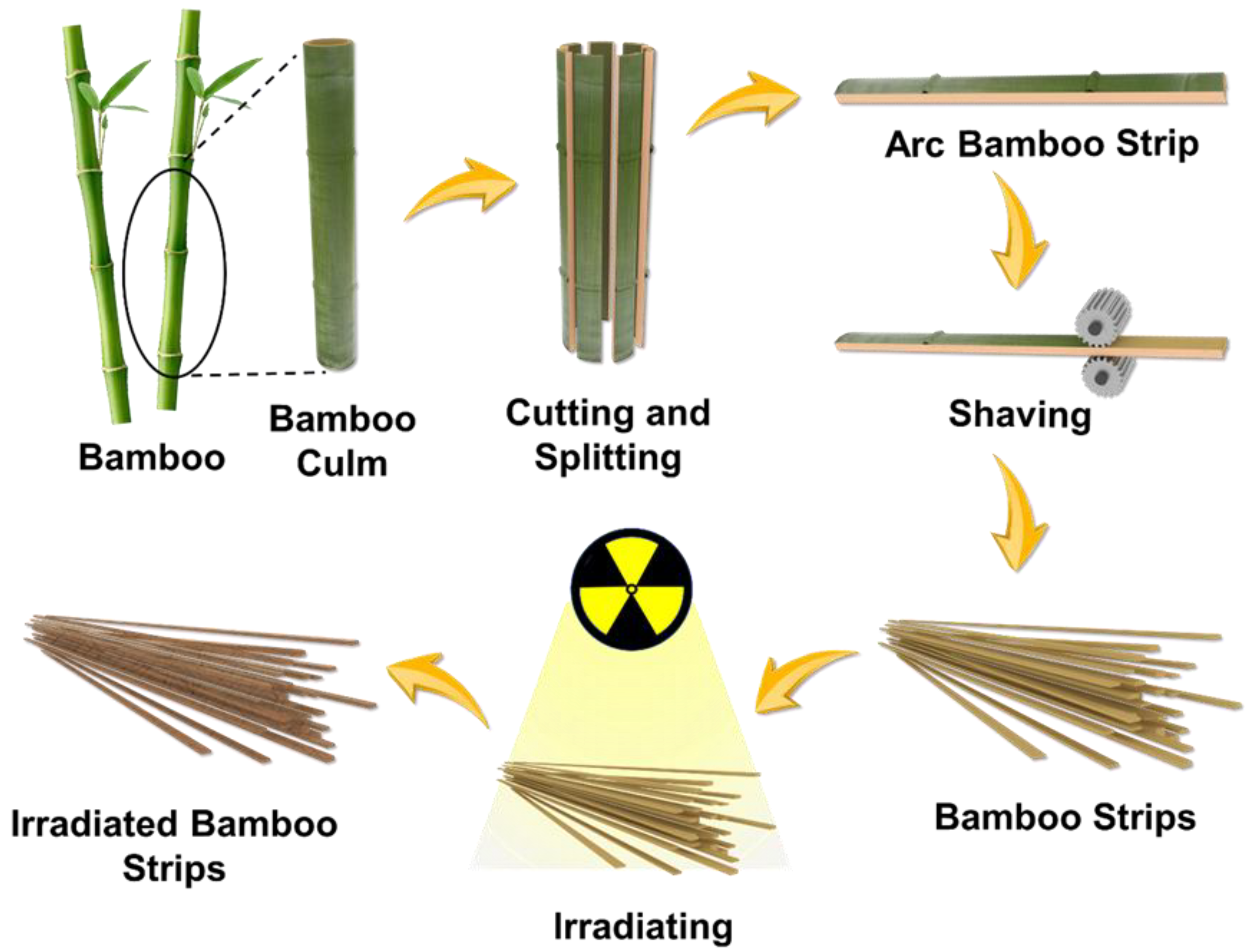
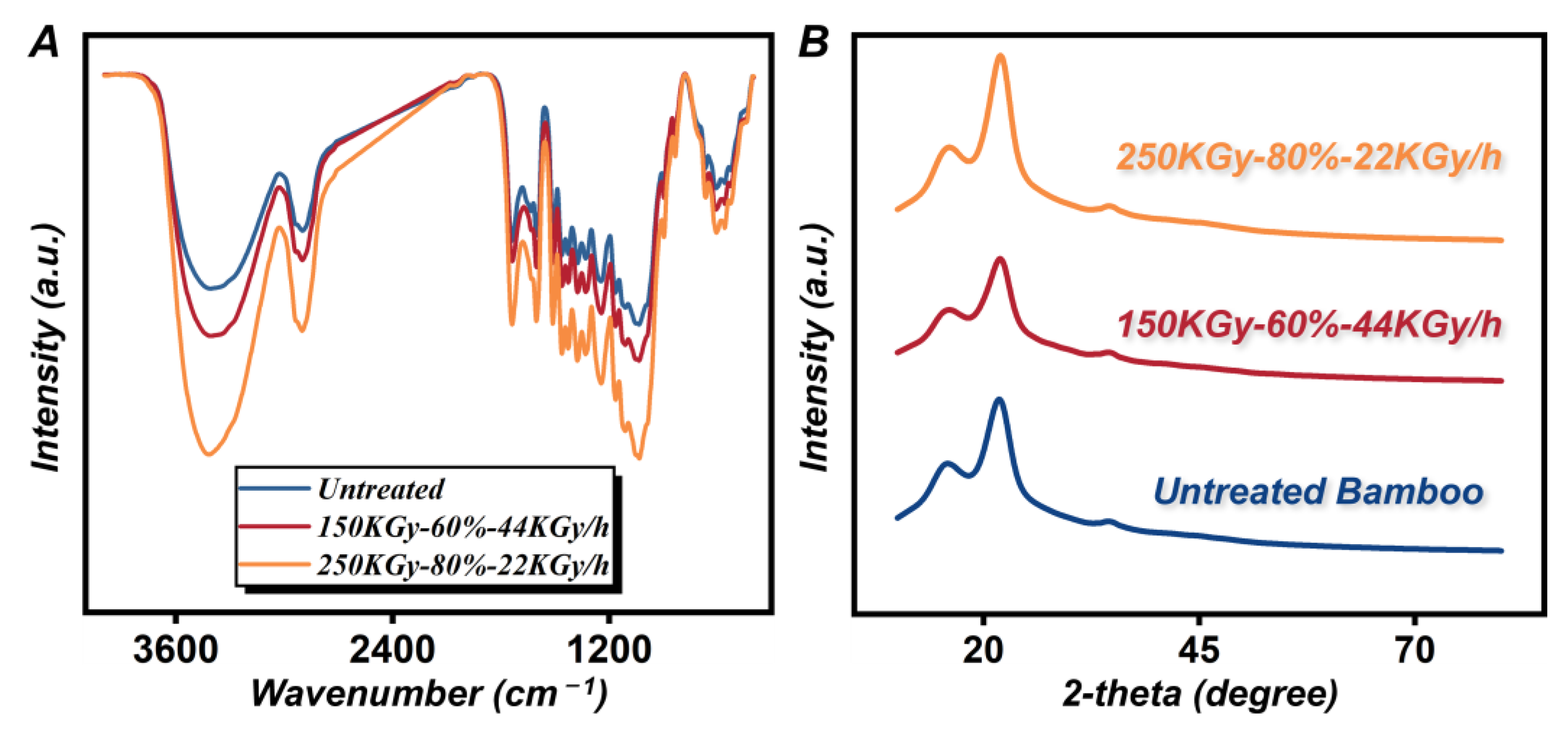
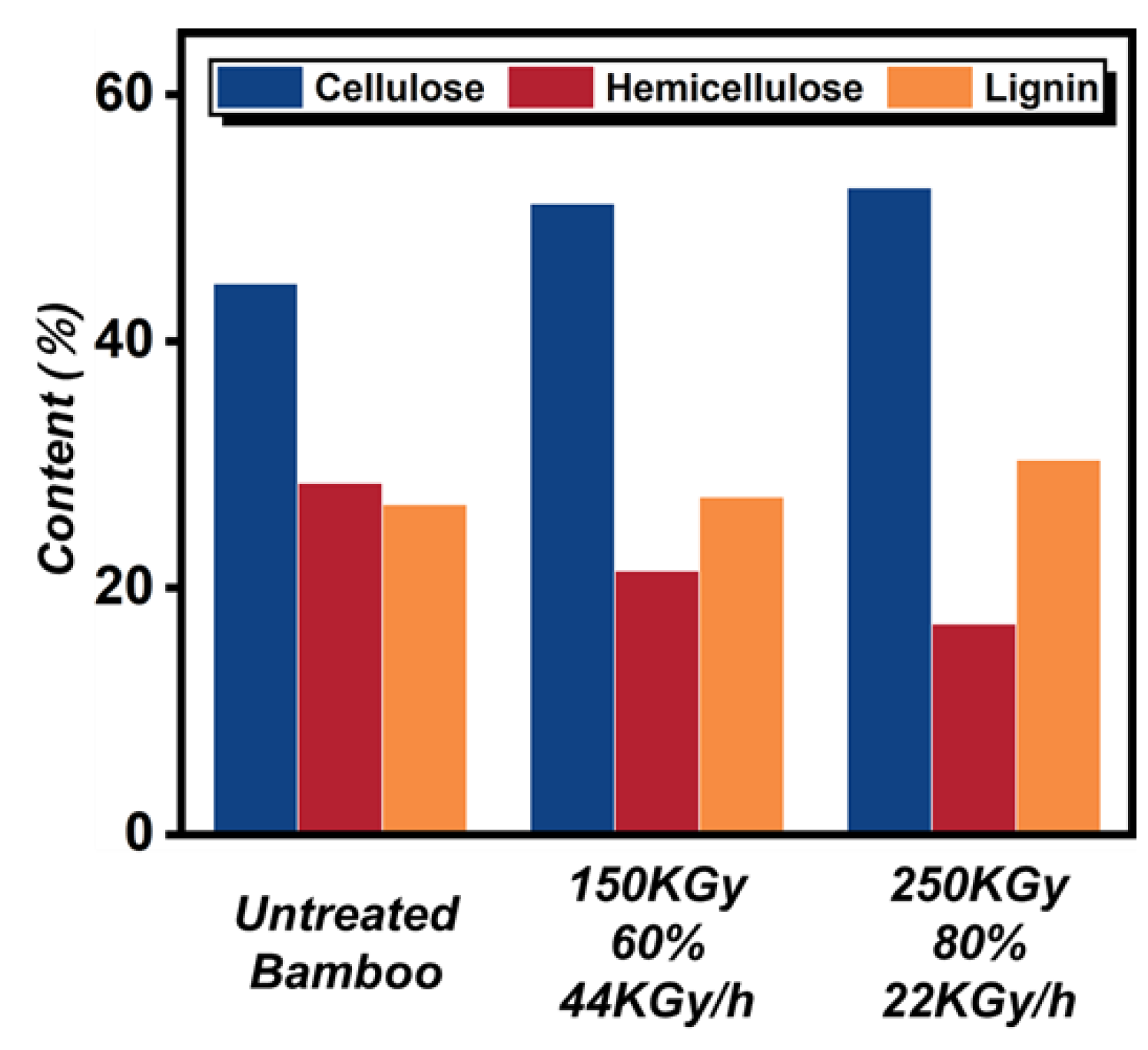
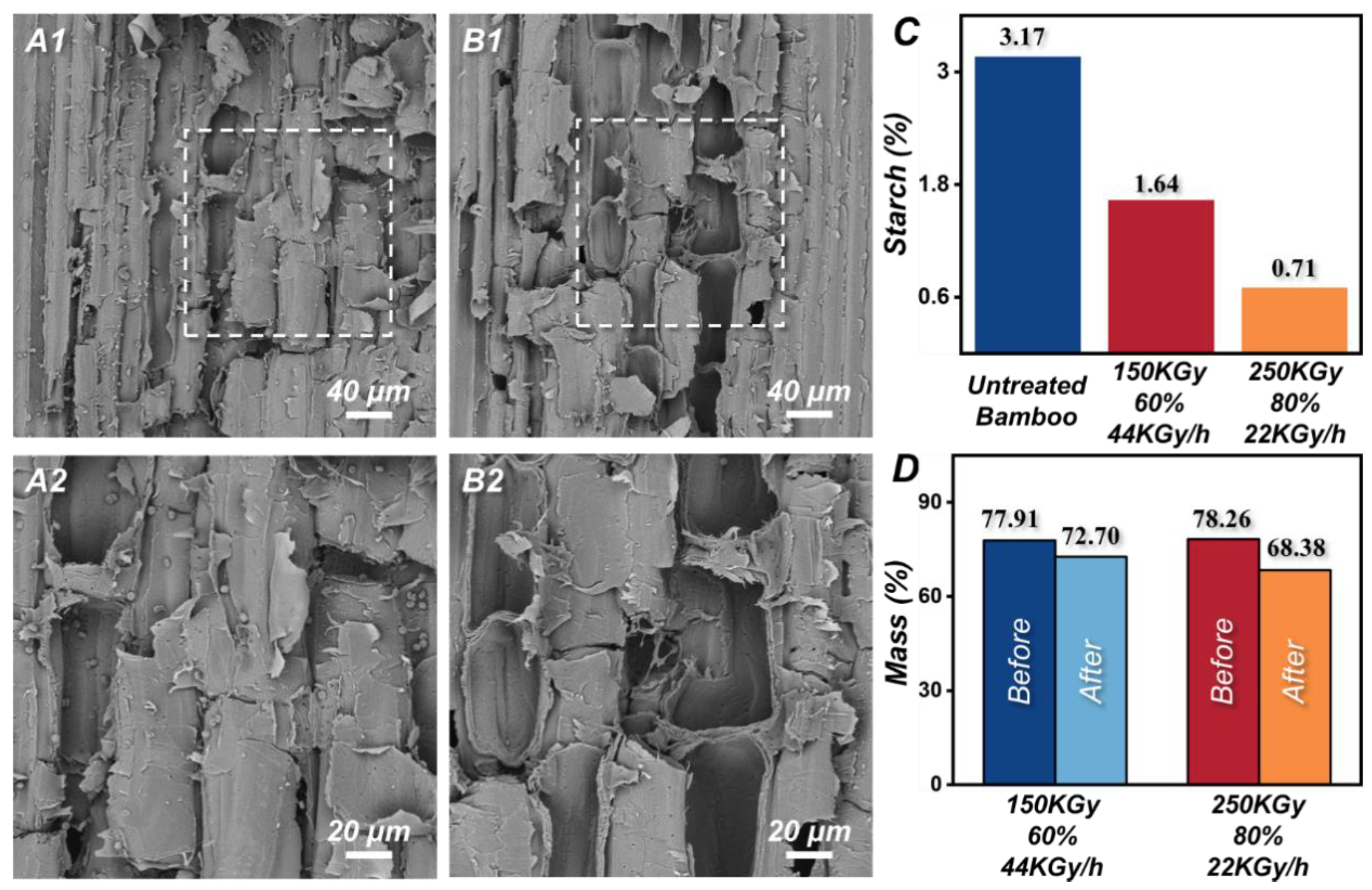
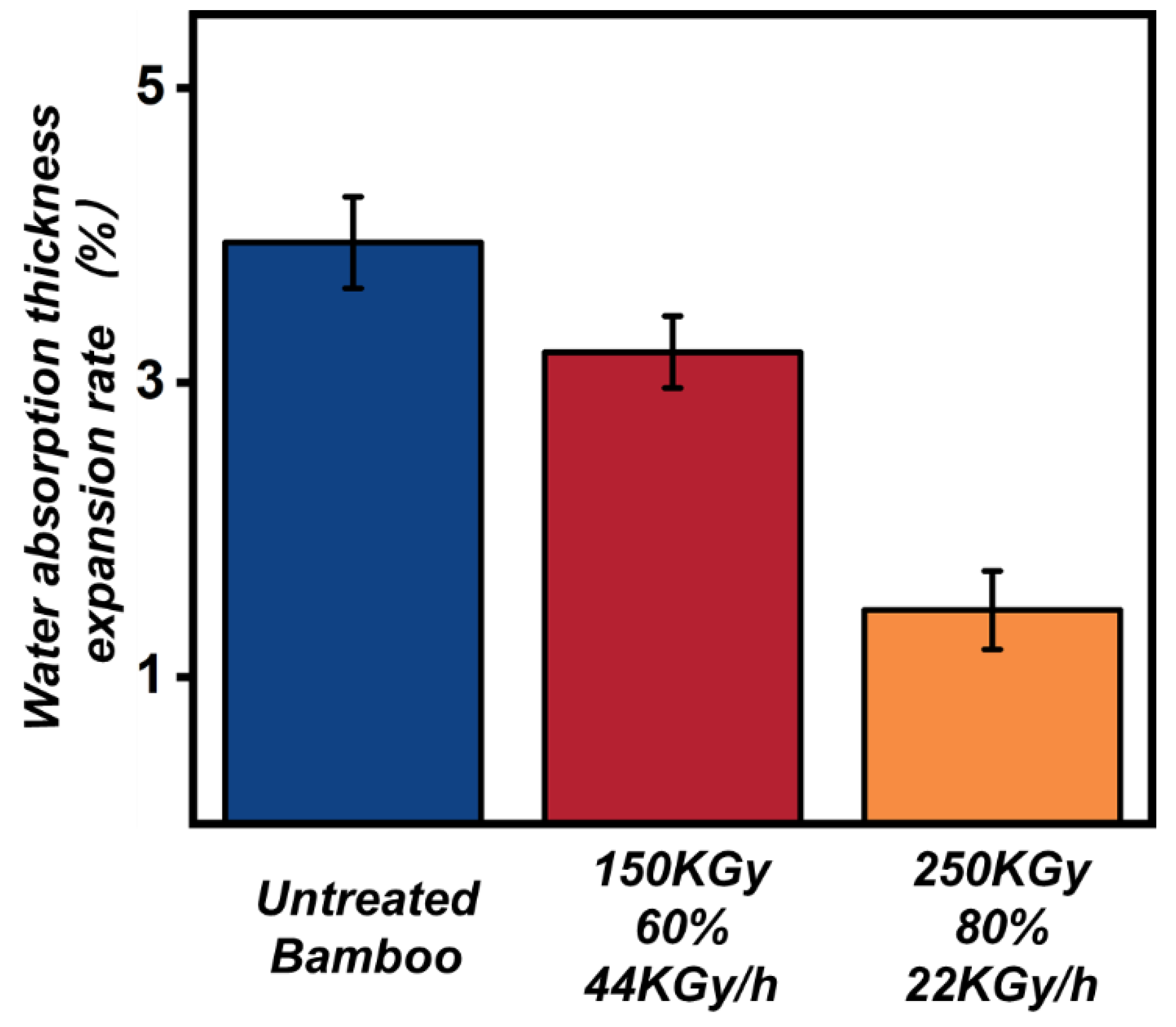

| Level | A Irradiation Dose (KGy) | B MC (%) | C Dose Rate (KGy/h) |
|---|---|---|---|
| 1 | 50 | 0 | 0.88 |
| 2 | 150 | 60 | 22 |
| 3 | 250 | 80 | 44 |
| Rate | Area Infected with Bamboo Strips |
|---|---|
| 0 | No visible growth |
| 1 | Mold covering up to 1/4 of the surface |
| 2 | Mold covering between 1/4 and 1/2 of the surface |
| 3 | Mold covering between 1/2 and 3/4 of the surface |
| 4 | Mold on greater than 3/4 of the surface |
| Experimental Number | Factors | R1 (MPa) | R2 (MPa) | R3 (MPa) | ||
|---|---|---|---|---|---|---|
| A (Irradiation Dose KGy) | B (Moisture Content %) | C (Irradiation Rate KGy/h) | ||||
| 1 | 1 | 1 | 1 | 105.33 | 8.36 | 108.11 |
| 2 | 1 | 2 | 2 | 106.63 | 8.63 | 110.00 |
| 3 | 1 | 3 | 3 | 108.94 | 8.88 | 114.25 |
| 4 | 2 | 1 | 2 | 114.65 | 9.02 | 110.14 |
| 5 | 2 | 2 | 3 | 122.14 | 9.29 | 116.67 |
| 6 | 2 | 3 | 1 | 110.93 | 8.86 | 113.12 |
| 7 | 3 | 1 | 3 | 80.23 | 7.91 | 70.67 |
| 8 | 3 | 2 | 1 | 79.55 | 8.09 | 72.05 |
| 9 | 3 | 3 | 2 | 70.06 | 7.91 | 64.05 |
| X1 (R1) | 106.97 | 99.74 | 98.60 | |||
| X2 (R1) | 115.91 | 102.78 | 97.11 | |||
| X3 (R1) | 76.28 | 96.64 | 103.44 | |||
| R (R1) | 39.63 | 6.13 | 6.33 | |||
| X1 (R2) | 8.62 | 8.39 | 8.42 | |||
| X2 (R2) | 9.02 | 8.65 | 8.48 | |||
| X3 (R2) | 7.95 | 8.55 | 8.69 | |||
| R (R2) | 1.07 | 0.26 | 0.28 | |||
| X1 (R3) | 110.79 | 96.31 | 97.76 | |||
| X2 (R3) | 113.31 | 99.57 | 94.73 | |||
| X3 (R3) | 68.92 | 97.14 | 100.53 | |||
| R (R3) | 44.39 | 3.27 | 5.80 | |||
| Sources of Variance | Sum of Squares for Deviations | Degrees of Freedom | Mean Square | F-Value | Significance |
|---|---|---|---|---|---|
| A | 2591.77 | 2 | 1295.89 | 323.01 | * 1 |
| B | 56.44 | 2 | 28.22 | 7.04 | |
| C | 65.60 | 2 | 32.80 | 8.18 | |
| Error | 8.02 | 2 | 4.01 | ||
| Sum | 2721.83 |
| Sources of Variance | Sum of Squares for Deviations | Degrees of Freedom | Mean Square | F-Value | Significance |
|---|---|---|---|---|---|
| A | 1.76 | 2 | 0.88 | 53.39 | * 1 |
| B | 0.10 | 2 | 0.05 | 3.03 | |
| C | 0.12 | 2 | 0.06 | 3.79 | |
| Error | 0.03 | 2 | 0.01 | ||
| Sum | 2.01 |
| Sources of Variance | Sum of Squares for Deviations | Degrees of Freedom | Mean Square | F-Value | Significance |
|---|---|---|---|---|---|
| A | 3729.03 | 2 | 1864.51 | 374.87 | * 1 |
| B | 17.31 | 2 | 8.66 | 1.74 | |
| C | 50.43 | 2 | 25.22 | 5.07 | |
| Error | 9.95 | 2 | 4.97 | ||
| Sum | 3806.72 |
| Group | 2θ/° | Relative Crystallinity/% | Lattice Spacing/nm |
|---|---|---|---|
| Untreated | 21.82 | 43.82 | 4.07 |
| 50 KGy-0%-0.88 KGy/h | 21.96 | 43.61 | 4.04 |
| 50 KGy-60%- 22 KGy/h | 21.88 | 45.72 | 4.06 |
| 50 KGy-80%- 44 KGy/h | 21.90 | 44.00 | 4.06 |
| 150 KGy-0%-22 KGy/h | 21.73 | 44.43 | 4.09 |
| 150 KGy-60%-44 KGy/h | 21.84 | 46.31 | 4.07 |
| 150 KGy-80%-0.88 KGy/h | 21.80 | 46.10 | 4.07 |
| 250 KGy-0%-22 KGy/h | 21.52 | 43.46 | 4.13 |
| 250 KGy-60%-0.22 KGy/h | 21.45 | 43.73 | 4.14 |
| 250 KGy-80%-44 KGy/h | 21.07 | 43.05 | 4.21 |
Disclaimer/Publisher’s Note: The statements, opinions and data contained in all publications are solely those of the individual author(s) and contributor(s) and not of MDPI and/or the editor(s). MDPI and/or the editor(s) disclaim responsibility for any injury to people or property resulting from any ideas, methods, instructions or products referred to in the content. |
© 2023 by the authors. Licensee MDPI, Basel, Switzerland. This article is an open access article distributed under the terms and conditions of the Creative Commons Attribution (CC BY) license (https://creativecommons.org/licenses/by/4.0/).
Share and Cite
Mao, S.; Xu, Z.; Wang, Q.; Han, X.; Wang, X.; Chen, M.; Li, Y. Effect of Irradiation Process on Physical and Chemical Properties and Mildew Resistance of Bamboo. Forests 2023, 14, 1055. https://doi.org/10.3390/f14051055
Mao S, Xu Z, Wang Q, Han X, Wang X, Chen M, Li Y. Effect of Irradiation Process on Physical and Chemical Properties and Mildew Resistance of Bamboo. Forests. 2023; 14(5):1055. https://doi.org/10.3390/f14051055
Chicago/Turabian StyleMao, Shengfeng, Zhuchao Xu, Qiuyi Wang, Xin Han, Xinzhou Wang, Meiling Chen, and Yanjun Li. 2023. "Effect of Irradiation Process on Physical and Chemical Properties and Mildew Resistance of Bamboo" Forests 14, no. 5: 1055. https://doi.org/10.3390/f14051055
APA StyleMao, S., Xu, Z., Wang, Q., Han, X., Wang, X., Chen, M., & Li, Y. (2023). Effect of Irradiation Process on Physical and Chemical Properties and Mildew Resistance of Bamboo. Forests, 14(5), 1055. https://doi.org/10.3390/f14051055








